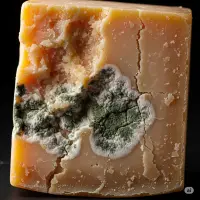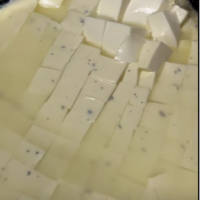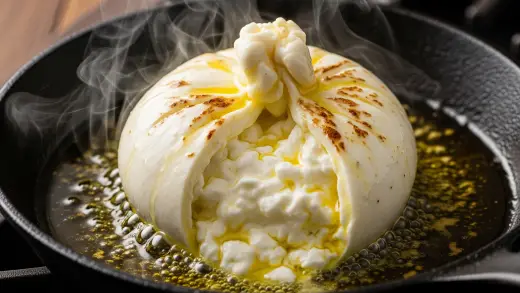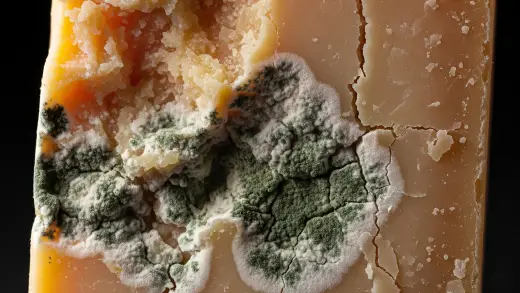Yes, the rind of Brie is generally edible and often enjoyed. It’s a bloomy rind formed by beneficial mold (Penicillium candidum) that is safe to consume and contributes to the cheese’s flavor and texture.
Ever wondered about that fuzzy white coat on your slice of Brie? You know, that soft, yummy cheese that’s like a creamy cloud? Lots of folks aren’t sure what to make of that outer layer.
Is it part of the cheesy goodness, or something you’re supposed to leave behind?
Well, let’s get right to it! Generally, yes, you absolutely can eat the Brie rind, and lots of people actually enjoy it! That delicate outside is a big part of what makes Brie so special.
In this little exploration, we’ll discover what the rind tastes and feels like. We’ll also touch on whether there are any things to keep in mind before you gobble it up.
And finally, we’ll even share some fun ideas on how to serve Brie, rind and all! So, get ready to learn more about this fantastic cheese.

Can You Eat The Skin Of Brie?
Yes, the rind of brie is absolutely edible! In fact, it’s a significant part of the cheese and contributes to its overall flavor and texture.
Here’s what you should know about the brie rind:
What it is
The white, slightly firm exterior of brie is called the “bloomy rind.” It’s formed by introducing a harmless mold, usually Penicillium candidum, to the surface of the cheese during the cheesemaking process.
Why it’s there
The rind protects the delicate, creamy interior of the brie as it ages and also imparts a subtle, earthy flavor to the cheese.
Flavor and texture
The rind has a mild, slightly mushroomy, and sometimes earthy taste. Its texture is usually soft and tender, providing a nice contrast to the smooth inside.
Etiquette
It’s generally considered proper to eat the entire piece of brie, rind and all. If you don’t enjoy the rind, it’s best to take a piece onto your plate and separate the rind from the inside there, rather than leaving rinds behind on a communal cheese board.
So, go ahead and enjoy the whole piece of brie! You might find that the rind complements the creamy interior beautifully.
Understanding Brie Rind: The Fuzzy Outside
That soft, white covering on your Brie cheese is called the rind, and it’s a pretty amazing part of the cheese-making process!
What’s it made of? This rind is mostly made up of a special kind of mold called Penicillium candidum. Don’t worry, it’s a friendly mold, kind of like the yeast that helps bread rise! These tiny organisms are sprayed on the outside of the young cheese and then get to work.
What does it do for the Brie? The rind plays a few important roles as the Brie develops. It helps give the cheese its shape and holds it together. More importantly, it helps create the unique flavors and the wonderfully soft, gooey texture inside. It also acts like a shield, protecting the delicate cheese as it ages.
How does it taste? The rind adds an interesting layer to the Brie’s flavor. You might notice an earthy or mushroom-like taste, and sometimes even a hint of nuttiness.
What does it feel like? The rind has a slightly different feel compared to the smooth, creamy inside. It can be a little firmer and sometimes a bit fuzzy, which gives a nice contrast in your mouth.
The Flavor Profile: Rind Power vs. Creamy Center
The rind and the inside of the Brie offer two distinct taste experiences that are fantastic together!
The Rind’s Taste: The rind often has a bolder flavor than the inside. It can be more intense, with those earthy and mushroomy notes we talked about. Some people even find it to have a slightly bitter edge, which adds complexity.
The Interior’s Taste: The inside of a good Brie is usually mild, buttery, and wonderfully creamy. It’s smooth and melts in your mouth, offering a rich and gentle flavor.
The Perfect Pair: When you eat the rind and the creamy interior together, they create a balanced and more complex flavor. The stronger notes of the rind mingle with the mildness of the inside, making each bite interesting and delicious.
Your Own Taste Adventure: Just like with any food, everyone’s taste buds are a little different! Some people absolutely love the rind and wouldn’t dream of cutting it off, while others prefer just the creamy center. There’s no right or wrong way – it’s all about what you enjoy!
A Little Bit About Nutrition
Good news – the Brie rind is generally safe for you to eat!
While there isn’t a lot of specific nutritional information just for the rind itself, it’s good to remember that Brie as a whole offers some calcium and protein. Keep in mind that it’s also a richer cheese, so moderation is key, just like with many tasty treats.
Are There Any Things to Think About?
For the most part, enjoying Brie rind is worry-free, but here are a few things to keep in mind:
Allergies: Although it’s not common, some people might have rare allergies to molds. If you know you have mold sensitivities, it’s always best to be cautious and maybe try a tiny bit of the rind first to see how you react.
Storage is Key: Like any dairy product, Brie needs to be stored properly in the refrigerator. This helps prevent any bad bacteria from growing. Always check the “best by” date and make sure your Brie smells fresh before eating it.
That Ammonia Smell: As Brie ages, you might notice a stronger smell of ammonia. This is a natural byproduct of the aging process and doesn’t necessarily mean the cheese is bad. However, the strong smell can sometimes affect the taste, and some people might not find it as appealing. If the smell is very strong, you might want to taste a small piece first to see if you still enjoy it.
Natural vs. Artificial: Traditional Brie has a natural, bloomy rind made by that friendly mold. You might occasionally find cheeses with a wax coating or other artificial coverings. These are not meant to be eaten, so always check the label!
How to Best Enjoy Brie with the Rind
Want to experience Brie at its finest? Here are a few tips:
Room Temperature Rules: Always let your Brie sit out at room temperature for about 30 minutes before serving. This softens the cheese and really brings out all those wonderful flavors in both the rind and the creamy center.
Perfect Partners: Brie with the rind is fantastic with so many things! Try it with sweet fruits like apples, pears, or berries. Crunchy nuts like walnuts or almonds also make a great pairing. Serve it with simple crackers or a crusty baguette. And of course, a nice glass of wine can really elevate the experience!
Brie in the Kitchen: Don’t be afraid to get creative! Brie (rind and all) is delicious baked until melty and gooey. It also adds a lovely creaminess and flavor to sandwiches.
Taking the First Bite: If you’re a little unsure about the rind, try taking a small bite of the Brie with both the rind and the inside together. You might be surprised at how well the flavors and textures work together!
Conclusion: Embrace the Rind!
So, there you have it! The rind on your Brie is not just okay to eat – it’s actually a delicious and important part of the whole Brie experience. It adds unique flavors and textures that complement the rich, creamy interior.
We encourage you to be a little adventurous and give the rind a try! You might just discover a new favorite part of this wonderful cheese.
Now, we’d love to hear from you! Have you tried Brie rind before? What did you think? Share your experiences and any tips you have in the comments below!















